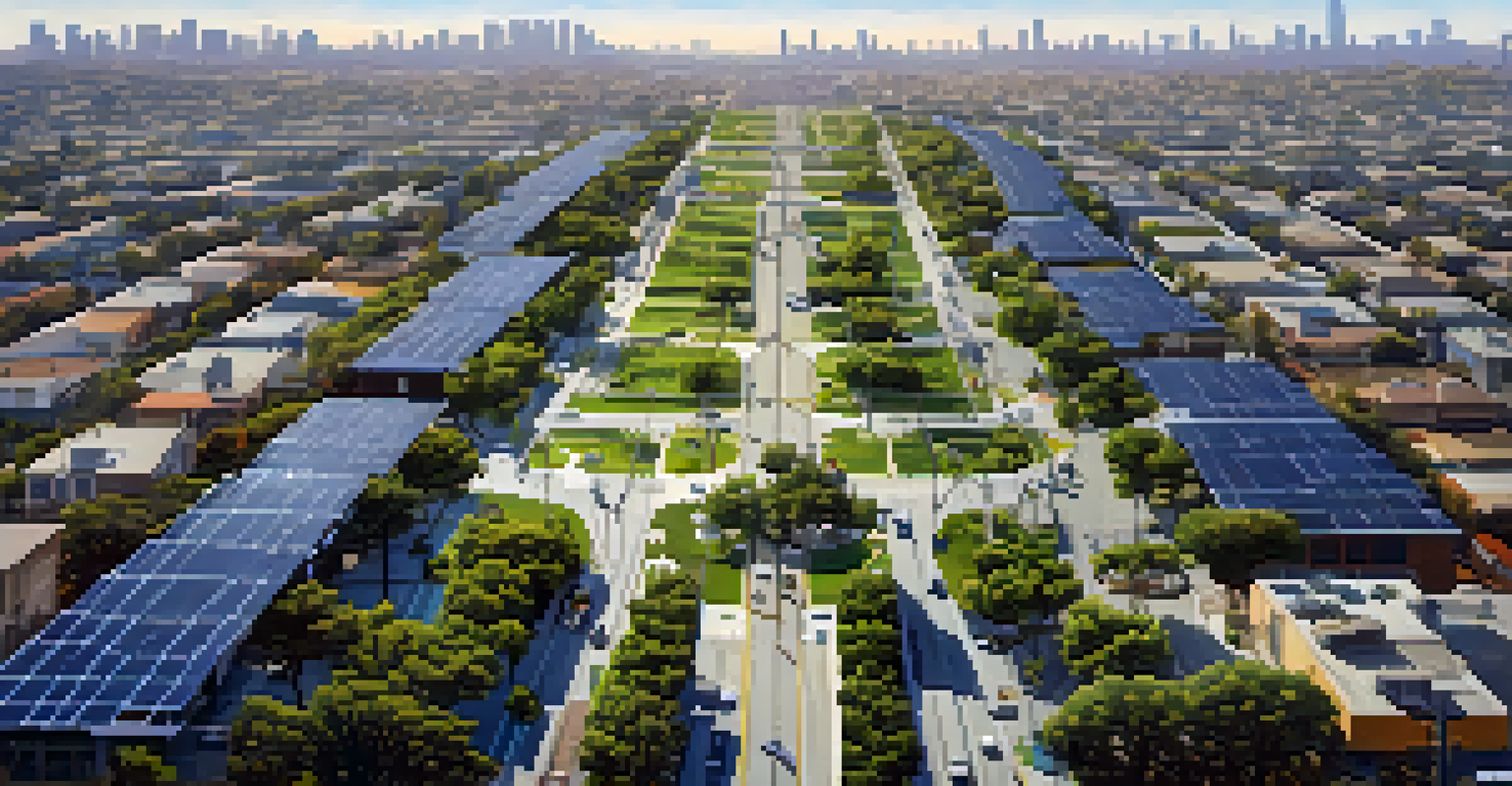Transportation Challenges: Climate Change and LA Infrastructure

Understanding the Impact of Climate Change on LA's Transport
Climate change is not just a buzzword; it's a reality that affects every aspect of our lives, including transportation. In Los Angeles, rising temperatures, increased rainfall, and wildfires challenge the resilience of the city’s infrastructure. This complex interplay makes it essential for city planners to rethink transportation systems in a more sustainable way.
The climate crisis is a race we can win, but we can only win it together.
For instance, extreme heat can warp rail tracks and degrade asphalt, leading to costly repairs and disruptions. Similarly, heavier rainfall can overwhelm drainage systems, causing flooding that hampers both private and public transportation. It's a delicate balance that requires immediate attention to adapt to these new environmental norms.
As LA's population grows and climate change intensifies, the urgency to develop robust and flexible transportation solutions becomes clearer. The city must consider not only current challenges but also future scenarios, ensuring that infrastructure can withstand whatever Mother Nature throws its way.
Current State of LA's Transportation Infrastructure
Los Angeles boasts an extensive transportation network, including roads, buses, and a growing metro system. However, this infrastructure is aging and often ill-equipped to handle the pressures of climate change. For example, many roads have potholes and cracks due to temperature fluctuations, which can lead to accidents and delays.

Public transportation options, while expanding, still face challenges such as inconsistent service and limited coverage in certain areas. This leaves many residents reliant on personal vehicles, which exacerbates traffic congestion and increases emissions. In a city where getting from point A to point B can often feel like a marathon, the need for improvement is glaring.
Climate Change Challenges LA Transport
Los Angeles faces significant transportation challenges due to climate change, necessitating a shift towards more sustainable systems.
Moreover, with climate change pushing for a greener approach, LA's transportation systems must evolve. Innovative solutions such as electric buses and improved bike lanes can help reduce reliance on fossil fuels and contribute to a cleaner environment.
The Role of Public Transit in Mitigating Climate Effects
Public transit is a pivotal player in LA's transportation landscape, especially in the face of climate change. By encouraging more residents to use buses and trains instead of cars, the city can significantly reduce greenhouse gas emissions. This shift not only helps the environment but also eases traffic congestion, making commutes quicker for everyone.
Sustainability is no longer about doing less harm. It's about doing more good.
Additionally, investments in public transit can create a more equitable transportation system. Many low-income families rely on these services for their daily journeys, and by enhancing public transit, we can ensure that all Angelenos have access to reliable transportation. This inclusion is crucial for economic mobility and community well-being.
However, public transit must also be resilient to climate impacts. Infrastructure improvements, such as elevated train tracks and stormwater management systems, can help safeguard public transit against extreme weather events, ensuring that it remains a viable option for years to come.
Innovative Solutions for Sustainable Transportation
As Los Angeles grapples with its transportation challenges, innovative solutions are emerging to promote sustainability. Electric vehicles (EVs) are becoming increasingly popular, and with the expansion of charging stations, they present a cleaner alternative for commuters. The city is also exploring the integration of smart technology to manage traffic flow and reduce congestion.
Another exciting development is the rise of bike-sharing programs and pedestrian-friendly initiatives. By creating more bike lanes and walkable areas, LA can encourage residents to choose healthier and more sustainable modes of transport. This not only benefits the environment but also promotes a sense of community and well-being.
Public Transit Reduces Emissions
Enhancing public transit can lower greenhouse gas emissions and improve accessibility for low-income families in LA.
Moreover, collaboration between city officials, private companies, and community organizations can fuel these innovations. By working together, stakeholders can identify challenges and implement solutions that are not only effective but also tailored to the unique needs of the city.
The Importance of Community Engagement in Planning
Community engagement is vital when addressing transportation challenges in LA, especially given the diverse population. It's essential for city planners to listen to the voices of residents and understand their transportation needs. Public forums, surveys, and workshops can provide invaluable insights, ensuring that solutions are relevant and effective.
When communities are involved in the planning process, they feel a sense of ownership over their transportation systems. This can lead to increased usage of public transit and support for new initiatives, creating a win-win situation for everyone involved. Engaged communities are more likely to advocate for sustainable practices and hold decision-makers accountable.
Additionally, highlighting success stories from community-led initiatives can inspire others and promote a culture of collaboration. By showcasing how local efforts can lead to meaningful change, LA can foster a shared vision for a sustainable transportation future.
Funding and Policy Challenges for Infrastructure Improvement
Securing funding for transportation infrastructure improvements remains a major hurdle for Los Angeles. While there are various sources of funding, such as state and federal grants, competition for these resources is fierce. City leaders must prioritize projects that address both immediate needs and long-term sustainability goals.
Moreover, policy challenges can impede progress. Regulations and bureaucratic red tape can slow down the implementation of innovative transportation solutions. Streamlining processes and creating supportive policies can empower city planners to take bold steps toward a more sustainable transportation infrastructure.
Community Engagement is Essential
Involving residents in transportation planning fosters ownership and supports sustainable practices in Los Angeles.
To navigate these challenges, it's essential for LA to foster partnerships with private entities and non-profits. Collaborative efforts can create innovative funding mechanisms and share the burden of risk, ultimately leading to successful transportation projects that benefit the entire community.
Looking Ahead: The Future of LA Transportation
As we look to the future, the transportation landscape in Los Angeles will undoubtedly evolve in response to climate change. The city has the opportunity to redefine what transportation means by prioritizing sustainability and resilience. This vision could include expanded public transit options, more pedestrian-friendly spaces, and innovative technologies that minimize environmental impact.
Investing in infrastructure that can withstand climate-related challenges will be crucial. Future projects must incorporate adaptive designs that consider rising sea levels, extreme heat, and flooding. This proactive approach can mitigate risks and ensure that the transportation system remains functional in the face of adversity.

Ultimately, the goal is to create a transportation network that not only meets the needs of current residents but also benefits future generations. By embracing change and innovation, Los Angeles can become a model for sustainable urban transportation, paving the way for a greener, more connected city.